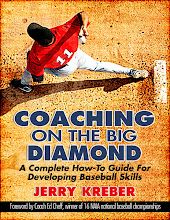Monday, January 09, 2006
Linear Hitting: The Stretch

Linear Hitting Part II:
“The Stretch”
In the previous article, I described the first stage in our hitting philosophy called “The Load”. After the load of the back leg has been completed, the second stage in our hitting philosophy can be performed. As soon as the stride foot is placed down our hitters are in “The Stretch” stage of the swing. Dr. Chris Yeager does an excellent job of describing this stage in his DVD series.
Simply, when we explain this stage to our players, after foot plant as occurred the hitter’s weight should be forward and their hands should stay back. The hitter, going into the stride, must attack the ball. By incorporating an attack movement, the hitter must transfer their weight from the back to front on a bent front leg. If the front leg is extended, the hitter’s weight will not be forcefully transferred.
During the load, as the hitter’s weight transfers to the rear, their hands will naturally take a backward movement as well. This makes sense because the rest of their body is moving backward during “The Load” stage. To get into “The Stretch” stage of the swing, the hitter’s hands, which moved backwards, stay there as the hitter’s weight moves forward. Usually, the hitter’s hands are even with the rear foot. When this happens, the hitter’s lead arm becomes extended and the hitter can feel a stretch in their tricep.
The tricep is not the only muscle that receives a stretch. The groin is another muscle, which the hitter should feel stretched after the stride foot has landed. Since the hitter is attacking the ball in a straight line, their back leg may become extended after the stride as all the weight is transferred to their front side. With a flexed front side leg, the hitter’s rear foot may be partially off the ground. To fully understand, examine the above illustration. Notice, the hitter has transferred their weight forward, but left their hands back. The hands, which should be relaxed, are almost even with their back foot.
Relaxing the hands is important because it allows the bat barrel to follow the hands to the ball. Thus, with the relaxation, keeping the hitter in a straight line during the swing. This can be measured by the bat angle of the hitter in the “Stretch Position.” If the hitter uses loose muscles, the bat should slightly lag around the head area. If the hitter’s muscles tighten, the bat will be in a straight up/down positioning. When the bat is up/down, the hitter’s barrel usually tends to lead. If the barrel leads the swing, the hands create a circular path and all the straight-line principles are out the window.
In conclusion, we teach our hitters to relax, keeping their weight forward and hands back. In the last article of this series, I will discuss the swing’s final stage ‘The Fire” and how hitters can incorporate good extension through their swing.
